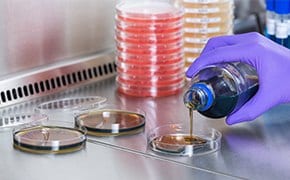Water for Microbiology Media Preparation

Microbiological Testing
Microbiological testing is performed to screen products and processes for the presence of potential contaminants. These analyses are of major importance in the food and beverage, pharmaceutical and cosmetic industries to ensure consumer products are safe. Common microbiology analyses include bioburden testing, pathogen testing, sterility testing, shelf-life testing, and air monitoring. Microbiology laboratories performing these tests are required to deliver accurate and reliable results and meet regulatory requirements while under time pressure.
Microbiology experiments involve several techniques, from microbial culturing to ELISA, PCR and sequencing. Many tests and procedures depend upon culture media being capable of providing consistent and reproducible results. This section focuses on water used for the preparation of culture media.
Water Quality Standards in Microbiology
The EN ISO 11133 standard1 establishes the context that ensures the quality of microbiological culture media and specifies the requirements for media preparation. Since over 90% of culture media formulation is water, water quality is critical for reliable and reproducible microbiological methods.
The main requirements for water used to prepare culture media as stated by the EN ISO 11133 standard are:
- The water should be purified, free from traces of chlorine, ammonia or metal ions, which are likely to inhibit or influence the growth of microorganisms
- The conductivity of the water should be < 25 μS/cm, preferably < 5 μS/cm
- The microbial contamination of the water should be < 103 cfu/mL, preferably < 102 cfu/mL
- The water shall be freshly purified, or stored in a container free from inhibiting substances, made of an inert material such as polyethylene (PE)
Lab Water Solutions for Microbiological Culture Media Preparation
Water quality defined as pure water or Type 2 water is recommended to prepare microbiological culture media. This water is prepared by a combination of purification technologies that include activated carbon, reverse osmosis, electrodeionization, a bactericidal lamp, and a 0.22 µm filter added at the point of delivery. This combination of water purification technologies ensures:
- The removal of ions that may influence microbial growth
- Conductivity < 0.2 μS/cm; typically 0.1 μS/cm
- Low microbial count
- Constant water quality
Pure water is typically stored in opaque plastic containers made of polypropylene (PP) or polyethylene (PE), equipped with a UV lamp to reduce microbial proliferation during storage.
This purified Type 2 water can also be used to feed lab equipment such as autoclaves or dishwashers, making it a versatile solution for microbiology laboratories.
If you require support to determine the best water purification solution for your microbiology laboratory and its applications, we invite you to:
Lab Water Solutions Support
If you would like support to determine the optimal water purification solution for your laboratory and its applications, please complete and submit the form below. Please specify your interest so we can customize our follow-up according to your needs. Fields indicated with an asterisk are required.
References
Para seguir leyendo, inicie sesión o cree una cuenta.
¿No tiene una cuenta?